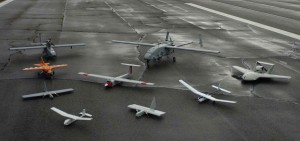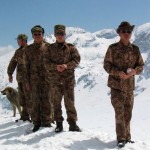IDR Blog
Employment and Control of UAVs

Various Unmanned Aerial Vehicles. Pictured are (front to back, left to right) RQ-11A Raven, Evolution, Dragon Eye, NASA FLIC, Arcturus T-15, Skylark, Tern, RQ-2B Pioneer, and Neptune.
The Indian Army has raised a new Army Aviation Brigade in March 2021 at Missamari in Assam close to Tezpur in backdrop of the Chinese build up and increased activities along the Line of Actual Control (LAC) in the Eastern Sector. Three squadrons of this new aviation brigade are operating from the Missamari Army Aviation Base. The equipment profile of this brigade includes armed Advanced Light Helicopters (ALH), Cheetah helicopters and Heron unarmed aerial vehicles (UAVs). The brigade is mandated with the task of increasing surveillance along the LAC in the the eastern sector. The new Army Aviation Brigade enables Eastern Command to coordinate actions and to have a more localized control.
While the function of the new aviation brigade is largely for Intelligence, Surveillance and Reconnaissance (ISR) activities of the Army, it has the capability to support the Army for other tasks as well…
On the eve of the 13th round of Corps Commander-level talks at Moldo in Eastern Ladakh on October 10, Army Chief General M M Naravane had mentioned that China’s increased infrastructure development along the LAC meant that it is there to stay, and it is a matter for concern, even as India will match the deployment. Earlier on October 8, an Indian publication, citing government sources, Indian troops had briefly detained some 200-300 People’s Liberation Army (PLA) soldiers who had intruded into Tawang in Arunachal Pradesh before pushing them back. However, China attacked the Indian media for spreading fake news.
While the function of the new aviation brigade is largely for Intelligence, Surveillance and Reconnaissance (ISR) activities of the Army, it has the capability to support the Army for other tasks as well on the LAC including quick reconnaissance by commanders, induction and de-induction of troops with full battle loads and support equipment, casualty evacuation and the like.
The notable feature in the new aviation brigade is the Israeli Remotely Piloted Aircraft (RPA) ‘Herons’ which have been transferred from under control of the Artillery to the Army Aviation control on September 15, 2021. According to a source, the artillery drone pilots have now moved to the Aviation Corps as part of the change. These RPAs (Heron MK-1) are keeping a close watch on activities of the PLA. The Heron MK 1 has an endurance of about 24-30 hours and can transmit back live video feed and images of about 200-250 km (range). Concurrently the Army is awaiting upgrades of these Herons as well new satellite link-enabled RPAs.
An important development is that the Army will get four Heron Mk 2 drones which are being shipped from Israel to India after being procured under emergency contract. The earlier plan was to lease the Heron MK-2 from Israel. However, this had to be reportedly changed to direct purchase at Israel’s instance since its experience of leasing by a European country ran into problems. The Heron MK 2 drones have longer endurance than its predecessor, and come with a more powerful engine and better radar.
…how long Project Cheetah will take is anybody’s guess because the Indian Air Force (IAF) which is the lead agency for this project will reportedly be budgeting for this program only in the later quarter of next fiscal.
The Army wants to revive and implement the ‘Project Cheetah’ earliest under which the military’s Heron UAVs will be upgraded with satellite links and armed with Israel’s help. With satellite-linked drones, the drones will have almost unlimited range of transmission enabling these systems to be fully exploited to their endurance capabilities. In the first phase of Project Cheetah, the UAVs are to be upgraded, and in the second phase they are to be armed with missiles.
However, how long Project Cheetah will take is anybody’s guess because the Indian Air Force (IAF) which is the lead agency for this project will reportedly be budgeting for this program only in the later quarter of next fiscal. Considering the aggressive posture of China, government needs to accord Project Cheetah top priority and make the funds available at the earliest since thereafter the upgrades and fitment of missiles on the Heron UAVs will take time and since it may not be possible to make all available for upgrades together since the tasks along the LAC cannot be neglected.
There has been renewed push to fill up the existing squadrons of ALH (Dhruv) and its weaponized version ALH (Rudra) to their sanctioned strength with the Rudra helicopters also providing cover to Dhruv helicopters close to the LAC especially when the Dhruv are being used to transport troops. But helicopters are a different class than the Heron UAVs, which reinforces the need for accelerating the implementation of Project Cheetah.
Looking back, the induction of drones in the Indian Military was unduly delayed for years on end because of the stonewalling by the Defence Research and Development Organization (DRDO) that they would meet the requirements but could not. As a nation perhaps we also did not visualize how soon UAV’s will flood the battlefield and even ignored China’s rapid technological developments.
The Army was the first to induct UAVs ex import. The IAF and Navy followed later. When the Searcher UAVs were inducted in the Army, their control went to the Artillery as it already had Surveillance and Target Acquisition (SATA) and as such were first responders in terms of information/intelligence. Army Aviation was then just being raised and therefore not in the reckoning.
… the ‘overall’ tasking, employment, operational control, communications, C&R set up and air space management including establishment of the airspace managmeent centre (s) will need deeper thought.
Eastern Command has placed the RPAs under command the newly raised Army Aviation Brigade which are Heron UAVs primarily for ISR. But the Army or rather the Military needs to take a long-term view of employment of UAVs in considering the following:
• The future is likely to witness induction of very large number of drones in the military.
• The infantry, mechanized forces, artillery, air defence artillery may all have variety of drones operated from ground launchers.
• The swarm drones are coming and probably the IAF would be the first to induct them. Army too will eventually have the ability to fire swarm drones through ground launchers.
• In certain cases drones of the Navy too will be employed in conjunction the other services.
• Killer UAVs that self destruct on the target or smart bombs type will also be employed.
In view of the above, the ‘overall’ tasking, employment, operational control, communications, control and reporting (C&R) set up and air space management including establishment of the airspace management centre (s) will need deeper thought. A senior veteran opines that control of hand-held and short-range UAVs with range up to 10-km and endurance of 30-45 minutes should be with the Infantry and Mechanized Forces and beyond 10-km and higher endurance UAVs with larger payloads should be with the Artillery.
The above are examples which do not cover the entire gamut of employment of UAVs as discussed above. It would be prudent for the Directorate of Military Affairs (DMA) headed by the Chief of Defence Staff (CDS) to work out a comprehensive ‘UAV Philosophy’ in this respect as the start point.




